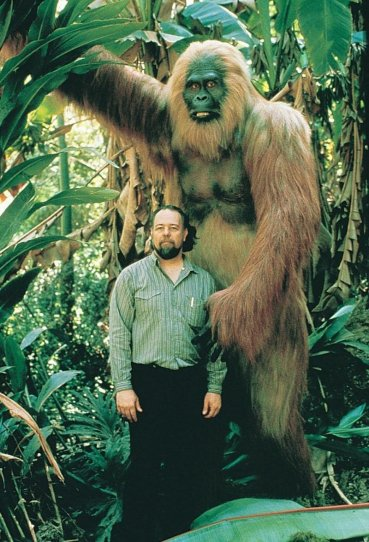From as long ago as 9 million years, all the way up to only 100,000 years ago, an enormous genus of ape roamed around the areas now known as China, India and Vietnam. It’s also possible that they co-existed with early humans. The first species of this genus to be discovered was Gigantopithecus blacki, and was actually found by chance. In 1935, archaeologist Ralph von Koenigswald found some fossilised teeth in a Chinese medicine shop, and realized that they were from an unknown species. The teeth were usually ground up and used as part of traditional medicines.

Ralph von Koenigswald. Source: http://collectie.tropenmuseum.nl/default.aspx?idx=ALL&field=*&search=10018632
While a full skeleton for the giant ape hasn’t yet been found, archaeologists can infer their size from dental remains that have been found. So, exactly how big were these apes? Scientists believe that the males could grow up to 10 feet tall, and weighed as much as 1,200 lb. Females were quite a lot smaller, due to sexual dimorphism. Like many other apes, they were most likely quadrupeds (this means that they moved around on four legs).

Cast of G. blacki’s lower mandible. Credit: Mark A. Wilson (http://commons.wikimedia.org/wiki/User:Wilson44691)

This is what the gigantopithecus may have looked like. Source: http://img102.fansshare.com/pic131/w/non-celebrity/369/13006_gigantopithecus_std.jpg?rnd=2700
G. blacki is thought to have lived in Southeast Asia, and dental analysis shows that it probably lived on bamboo and other plants. Furthermore, since the initial discovery of G. blacki, two more extinct gigantopithecus species have been found; Gigantopithecus giganteus and Gigantopithecus bilaspurensis. G. bilaspurensis lived in India, and G. giganteus appears to have lived in northern India and China. Despite its name, G. giganteus was actually about half the size of G. blacki.

Size comparison of gigantopithecus and human. Credit: http://en.wikipedia.org/wiki/User:Discott
Some conspiracy theorists believe that the gigantopithecus apes may still exist today, and are the reason why legends of Bigfoot, yetis and the like exist throughout the world. Unfortunately for proponents of this theory, there is no evidence that this is true. In fact, humans may have actually led to the decline and later extinction of the species, by using valuable resources that the apes needed to survive.
To read more on the subject, visit: http://www.uiowa.edu/~bioanth/giganto.html

You must be logged in to post a comment.